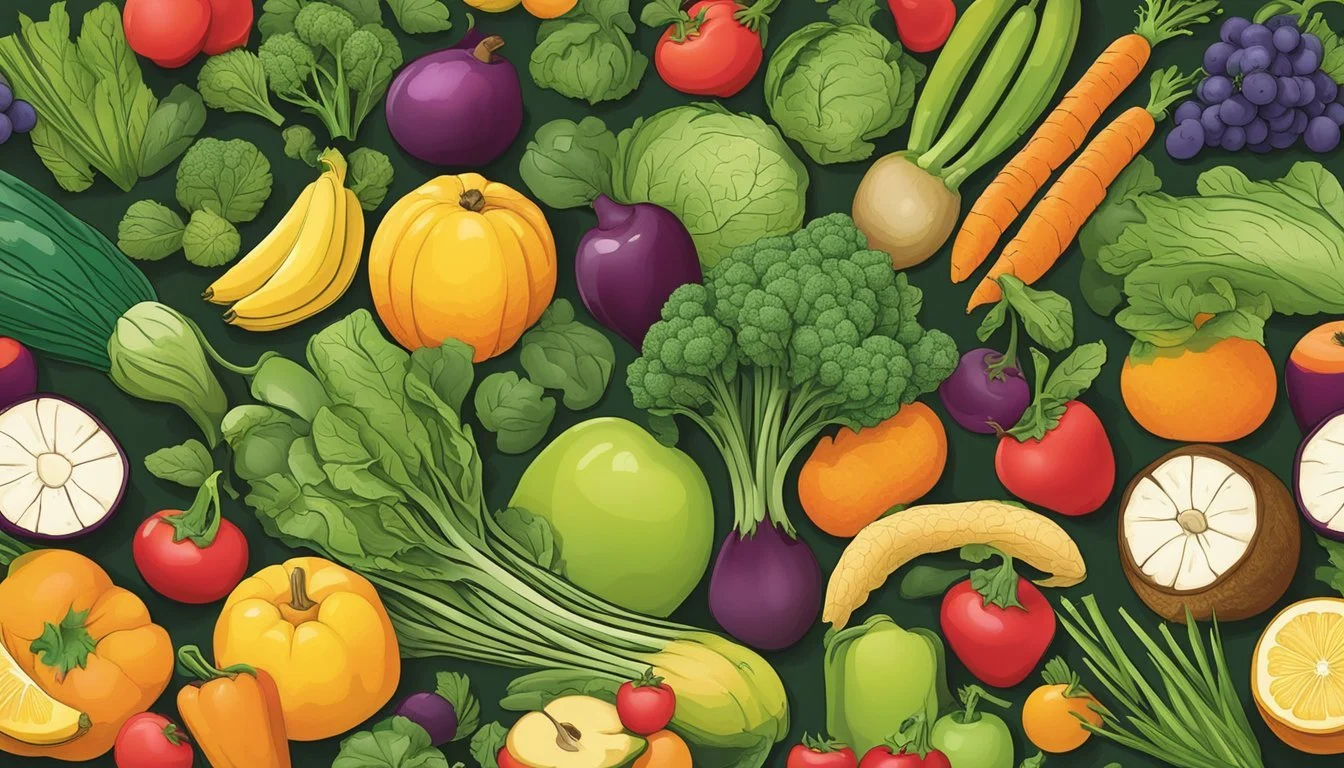Oklahoma Seasonal Fruit & Vegetables Guide in March
Fresh Picks and Choices
This Article is Part of our Oklahoma Seasonal Fruit & Veg Calendar
As the brisk Oklahoma winter yields to the early signs of spring, March emerges as a transitional month for local agriculture. Farmers and gardeners across the state begin to see the fruits of their labors as the first green shoots appear in their fields and plots. This period marks a critical time for planting and harvesting a variety of fruits and vegetables, with the changing climate playing a pivotal role in determining the success of each crop.
In Oklahoma, the produce available during March can vary due to the state's diverse weather patterns. However, certain crops are typically ready to be harvested during this month, offering fresh and flavorful options for consumers. Root vegetables and leafy greens are often at their prime, and with careful planning, growers can maximize their yields before the heat of summer sets in.
Gardening enthusiasts and commercial farmers alike must remain aware of the region's last frost dates and soil temperatures to ensure optimal growth. As such, they strategically select and cultivate crops that are robust enough to withstand the cooler nights and warm days common during Oklahoma's early spring. This precise approach to agriculture underscores the importance of understanding seasonal patterns, which not only supports local farming efforts but also provides residents with access to fresh, seasonal produce.
Seasonal Fruits Overview
As March unfolds, Oklahoma's fruit selection begins to transition from winter to early spring offerings. This mix includes lingering citrus to newly budding tree fruits, each bringing its own burst of flavor and nutrition. Residents and chefs alike look forward to incorporating these seasonal fruits into their diets.
Citrus and Tropical Fruits
March in Oklahoma sees the tail end of the citrus season. Lemons and other citrus fruits remain available, providing a tangy flavor, rich in vitamin C. These fruits are perfect for both raw consumption and adding a zest to recipes.
Tree Fruits in Season
While apples and pears are typically associated with fall, some late varieties might still be found in early March, offering a crisp and juicy component to both sweet and savory dishes.
Berries and Melons
Berries and melons are not usually in peak season in Oklahoma during March. However, as the weather begins to warm, the earliest strawberries might start to appear toward the end of the month, hinting at the sweetness of the coming seasons.
Fruits Perfect for Salads
Adding raw fruits like sliced apples to salads offers a fresh, sweet contrast to leafy greens. Avocados, although not locally in season, are popular in salads for their creamy texture and healthy fats.
Using Seasonal Fruits in Recipes
March fruits are versatile in the kitchen. Citrus can be used to marinate proteins or accentuate sides. Apples can be baked, roasted, or stewed for various dishes, from breakfasts to desserts.
Health Benefits of March Fruits
Seasonal fruits in March provide essential nutrients. They are typically low in calories, rich in fiber, and full of antioxidants, perfect for a healthy lifestyle.
Fruit Harvesting and Storage
Proper harvesting and storage ensure maximum flavor and longevity of fruits. For example, citrus fruits are best stored in a cool, dry place while apples may last longer when kept in the refrigerator.
Where to Find Local Produce
Local farmers' markets and Oklahoma's fresh produce stands start to offer the early bounties of spring. Finding local produce ensures that the fruits are at their freshest and most flavorful.
Preparing Seasonal Fruits
Whether eaten raw or prepared, March fruits are a delight. They can be steamed with vegetables, roasted alongside meats, or simply enjoyed in their natural state for a burst of freshness.
End of Winter Fruits
As February comes to a close, fruits that thrive in cooler temperatures make their final appearances. These include the last of the citrus fruits that have brightened the winter months with their vibrant flavors and colors.
Seasonal Vegetables Guide
In March, Oklahoma's gardens begin to yield a variety of seasonal vegetables. This guide details which vegetables one can expect to find and how to optimize their use during this month.
Leafy Greens and Cruciferous Vegetables
In March, leafy greens such as spinach and kale come into season. Gardeners can also enjoy cruciferous vegetables including broccoli, cauliflower, and cabbage. These vegetables are versatile, perfect for salads or can be lightly steamed to retain their nutritious value.
Root Vegetables and Squashes
Root vegetables like carrots and potatoes are still available in March, providing earthy flavors ideal for soups and roast dishes. Sweet potatoes and winter squash can also be harvested, offering a sweet, dense addition to meals.
Pods and Seeds Vegetables
Peas and snap peas start to make their appearance in the garden this month. They add a fresh, sweet crunch to dishes and are excellent when eaten raw or lightly cooked to maintain their crisp texture.
Alliums and Aromatic Vegetables
Garlic, onions, and leeks are key aromatic vegetables that one can find in March. They serve as foundational flavors for countless recipes, enhancing the taste profiles of a wide range of dishes with their robust flavors.
Cooking with Seasonal Vegetables
Chefs and home cooks alike prize the robust flavor of these vegetables. Incorporating them into recipes maximizes the taste of fresh, in-season produce.
Health Benefits of March Vegetables
Vegetables such as spinach and kale are rich in vitamins and minerals, and their consumption is linked to numerous health benefits. Eating a variety of March vegetables contributes to a healthy, balanced diet.
Vegetable Gardening Tips
For March gardening, one should focus on planting cool-weather crops. Spinach, lettuce, and similar greens can be planted early in the month and will thrive in the cooler temperatures.
Local Markets and Vegetable Availability
Most March vegetables are readily available at local Oklahoma markets. Availability can vary, but one typically finds a good selection of fresh produce.
Preparing Seasonal Vegetables
Simple preparations like roasting or steaming enhance the natural flavors of March vegetables. Spinach and kale are also great raw in salads.
Transitioning to Spring Vegetables
As March progresses, early spring vegetables like asparagus (What wine goes well with asparagus?) and lettuce start coming into season, marking the transition from winter to spring produce and widening the available options for fresh, local produce.
Understanding In-Season Cycles
Recognizing the seasonal cycles of vegetables is crucial for anyone looking to enjoy the freshest possible ingredients. In March, gardeners and shoppers focus on the last of the cool-weather crops while anticipating the arrival of early spring offerings.
Culinary Techniques and Recipes
Exploring Oklahoma's seasonal fruit and vegetable bounty in March opens up a myriad of culinary possibilities. The following section articulates various ways one can create simple, healthy, and flavorful dishes, employing cooking techniques that best highlight the natural goodness of the produce.
Simple Seasonal Recipes
Asparagus is a star vegetable of March. An easy recipe to savor its freshness is a Roasted Asparagus Side Dish:
Preheat oven to 400°F (200°C).
Wash and trim the ends of the asparagus.
Toss with olive oil, salt, and a squeeze of citrus (lemon or orange) to enhance the flavor.
Spread asparagus on a baking sheet in one layer.
Roast for about 15-20 minutes until tender but still crisp.
Serve as a side or integrate into salads for a healthy addition.
Cooking Methods for Seasonal Produce
Cooking methods like steaming and roasting are superb for retaining nutrients and developing flavor profiles of March produce. To steam root vegetables like turnips and parsnips:
Peel and chop the vegetables.
Bring water to a boil in a steaming pot.
Place vegetables in the steaming basket, cover, and steam for 10-15 minutes until they are tender.
For those who enjoy a richer flavor, roasting might be the method of choice.
Flavor Pairings and Spices
To complement the vibrant flavors of March produce, certain herbs and spices can serve as worthy accompaniments. Sage pairs exceptionally well with roasted root vegetables, offering a warm and earthy note. Sprinkle finely chopped sage on root vegetables before roasting.
For salads and side dishes incorporating citrus, balsamic vinegar (how long does balsamic vinegar last?) or a light vinaigrette can introduce an acid component that balances well with the sweetness of the season's fruits, such as oranges and strawberries, offering a bright and refreshing taste.
Nutrition and Health Information
March brings a selection of seasonal fruits and vegetables to Oklahoma that are not only fresh and flavorful but also packed with essential nutrients. Consuming these seasonal foods can contribute to a balanced diet and support overall health.
Vitamins and Minerals in Seasonal Produce
In March, Oklahoman produce like leafy greens, broccoli, and cabbage are in abundance. These vegetables are excellent sources of vitamin C, which is crucial for immune function and skin health. Leafy greens, particularly, are also rich in vitamins A and K, iron, and antioxidants. These nutrients are best preserved when the produce is consumed raw or lightly cooked. Seasonal fruits such as strawberries, which typically begin to appear in March, are another delicious source of vitamin C and fiber.
Strawberries: High in vitamin C and antioxidants
Leafy Greens: Rich in vitamin A, vitamin K, and iron
Broccoli: Contains vitamin C, vitamin K, and folate
Cabbage: Good source of vitamin C and dietary fiber
Dietary Considerations for March Produce
Consumers seeking to maintain a healthy diet should consider incorporating a range of March's seasonal produce. The fresh fruits and vegetables are low in calories yet high in fiber, which can aid in digestion and provide a sense of fullness, potentially supporting weight management. Additionally, the high nutrient density of these foods means one can obtain a significant amount of vitamins and minerals relative to their calorie content—favorable for those monitoring their caloric intake.
Select fresh produce: Emphasize consumption in raw forms to maximize nutrient retention.
Diversify intake: Combine a variety of March fruits and vegetables to cover a broad spectrum of nutrients.
Understand portion sizes: Be mindful of serving sizes to maintain a balanced diet.
Incorporating these seasonal foods into one's diet not only supports health and well-being but also aligns with a sustainable approach to eating, as seasonal produce is often sourced locally, reducing transportation and storage impacts.





